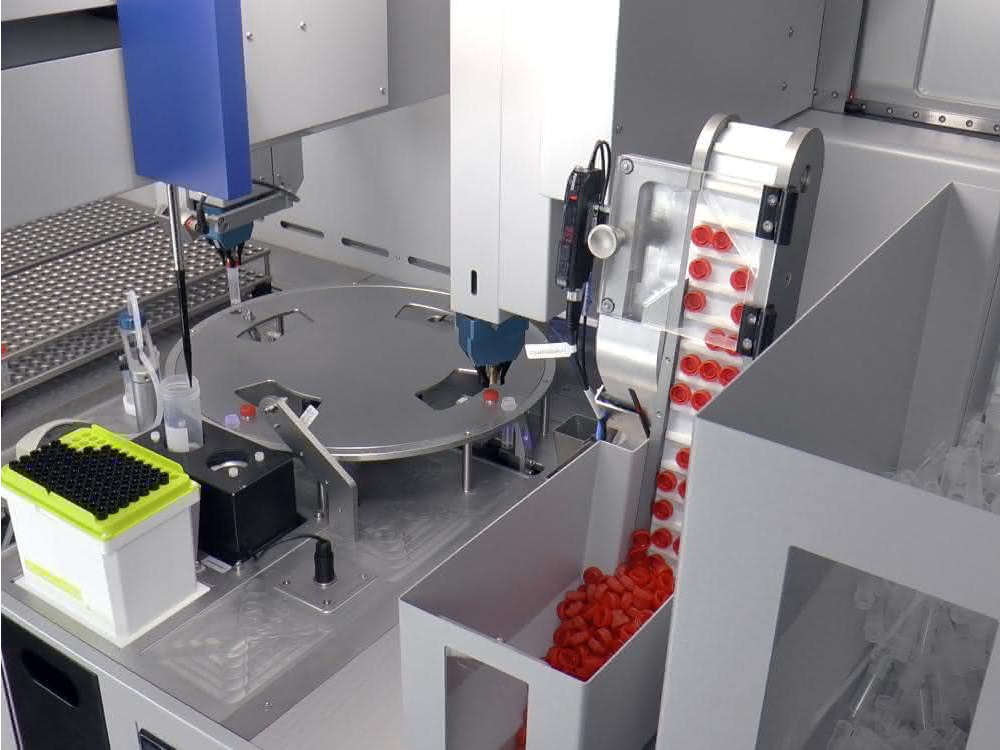Automated tube capping
Automation in the laboratory: Efficient capping of microscrew tubes
Automation has revolutionized many areas in recent years, and the laboratory is no exception. A particularly impressive example of automation in the laboratory is the application for screwing and unscrewing microscrew tubes. This innovation not only increases efficiency, but also reduces the workload for skilled workers and opens up space for more demanding activities.
1. Specialists can concentrate on more valuable tasks
Automating the micro-screw tube assembly process means that highly skilled professionals can focus their skills on more complex and valuable tasks. Instead of wasting valuable time on repetitive, manual wrenching, experts can focus their energy and creativity on analysis, research and problems that require human intelligence.

Automatic screwing and filling of microscrew tubes
2. No more monotonous tasks
The monotonous strain of screwdriving work, also known as capping and decapping, can lead to fatigue, loss of concentration and even human error. Automating this process completely eliminates these monotonous tasks. Machines can deliver the same precision and consistency without deviation, no matter how many screw tubes need to be screwed together. This not only reduces the risk of errors, but also increases the overall quality of the work carried out.
3. Physical relief
The constant screwing and unscrewing of microscrew tubes can lead to physical strain, especially during long working hours. Automation takes over these physically demanding tasks, which significantly reduces the workload for employees. This not only contributes to an improved working environment, but can also help to reduce injuries associated with repetitive movements.

4. Increased efficiency and cost savings
Automation in the laboratory not only offers qualitative advantages, but also enables a considerable increase in efficiency. The time gained through automated processes can be used for additional experiments, analyses or research activities. This in turn contributes to the acceleration of scientific progress. In addition, cost savings can be achieved by reducing the need for manual work and avoiding errors.

4. Conclusion
The automation of the screwing process for microscrew tubes in the laboratory has a number of advantages. By relieving skilled workers of repetitive tasks, it allows them to concentrate more on more demanding tasks. The avoidance of monotonous tasks and the physical relief not only contribute to the well-being of employees, but also improve the overall quality of the work performed. With the increasing integration of automation technologies in the laboratory environment, we can look forward to seeing what further innovations the future holds for scientific research.
X-TubeProcessor®_Basic
Your Tube-Processing –
Simply Automated
With the X-TubeProcessor_Basic, time-consuming manual capping and uncapping of tubes in your laboratory is a thing of the past.

Core functions:
- Screwing and unscrewing
- Labeling & marking
- Infeed belt
- Cap- / TubeFeeder
- Data management
- 6 SBS racks
- Process up to 600 tubes per hour
X-TubeProcessor®_Smart
Small footprint:
Tube- und liquid handling
Labor-Automatisierung auf kleinstem Raum: Entdecken Sie die kompakte und kostensparende Automatisierungslösung für das Öffnen, Befüllen, Etikettieren und Verschließen von Mikroschraubröhrchen.

Kernfunktionen:
- Etikettieren & Kennzeichnen
- Verschrauben und Entschrauben
- Peristaltik Pumpe
- Air displacement Pipette (ADP)
- Steriles Arbeiten durch HEPA-Filter
- Prozessschritte paralell bearbeiten
- Cap- / TubeFeeder
- Datenmanagement

